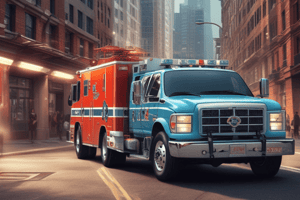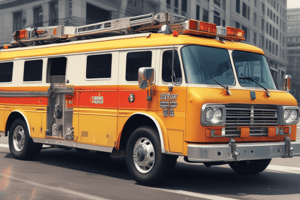Podcast
Questions and Answers
When should all persons riding on fire apparatus be secured by seat belts?
When should all persons riding on fire apparatus be secured by seat belts?
- During emergency medical care
- When the vehicle is stationary
- At the discretion of the emergency vehicle driver
- Only when the vehicle is in motion (correct)
What should the driver do if conditions make the use of a spotter impossible when backing a fire department vehicle?
What should the driver do if conditions make the use of a spotter impossible when backing a fire department vehicle?
- Ask for assistance from the passengers
- Make a circle of safety (correct)
- Use rearview camera if available
- Proceed with caution
What measures should be followed when backing a suppression apparatus with 3 or more individuals on board?
What measures should be followed when backing a suppression apparatus with 3 or more individuals on board?
- Ask the passengers to guide the backing
- Use a rearview camera
- Use 2 spotters at the rear of the vehicle (correct)
- Rely on the driver's side mirror
What should the driver do if they lose sight of the spotters while backing a suppression apparatus?
What should the driver do if they lose sight of the spotters while backing a suppression apparatus?
What should the driver do before attempting to back-up any fire department vehicle if conditions make the use of a spotter impossible?
What should the driver do before attempting to back-up any fire department vehicle if conditions make the use of a spotter impossible?
What should all drivers do when backing a staff vehicle?
What should all drivers do when backing a staff vehicle?
What should be done if injuries occur in a department vehicle involved accident?
What should be done if injuries occur in a department vehicle involved accident?
Who is responsible for initiating the drug test if the driver of the department vehicle causes an accident?
Who is responsible for initiating the drug test if the driver of the department vehicle causes an accident?
When should the accident report and related documents be turned in if the accident occurs on a weekend?
When should the accident report and related documents be turned in if the accident occurs on a weekend?
Who will investigate the accident along with the Shift BC if the driver of the department vehicle causes an accident?
Who will investigate the accident along with the Shift BC if the driver of the department vehicle causes an accident?
What is the purpose of Standard Operating Guidelines # 1010.07.00?
What is the purpose of Standard Operating Guidelines # 1010.07.00?
What is the main responsibility placed on the drivers of emergency vehicles?
What is the main responsibility placed on the drivers of emergency vehicles?
What assets are emergency vehicle drivers responsible for during a response?
What assets are emergency vehicle drivers responsible for during a response?
What must emergency vehicle drivers constantly monitor and reduce during each response?
What must emergency vehicle drivers constantly monitor and reduce during each response?
What is the purpose of the Circle of Safety?
What is the purpose of the Circle of Safety?
What does the use of Audible & Visual Warning Devices aim to accomplish?
What does the use of Audible & Visual Warning Devices aim to accomplish?
What is the focus of the Intersection Practices outlined in the guidelines?
What is the focus of the Intersection Practices outlined in the guidelines?
What is the Riding Policy related to in the guidelines?
What is the Riding Policy related to in the guidelines?
What does the Backing procedure outlined in the guidelines address?
What does the Backing procedure outlined in the guidelines address?
What is the purpose of the Department Involved Vehicle Accident section in the guidelines?
What is the purpose of the Department Involved Vehicle Accident section in the guidelines?
What is the first priority for all emergency vehicle drivers?
What is the first priority for all emergency vehicle drivers?
What must be ensured before moving the vehicle?
What must be ensured before moving the vehicle?
When should audible and visual warning devices be used during emergency response?
When should audible and visual warning devices be used during emergency response?
Where should emergency vehicles travel on roads with four or more lanes?
Where should emergency vehicles travel on roads with four or more lanes?
What is the recommended speed limit adherence during emergency response?
What is the recommended speed limit adherence during emergency response?
What specific practices should be followed at uncontrolled intersections?
What specific practices should be followed at uncontrolled intersections?
How should drivers approach controlled intersections during emergency response?
How should drivers approach controlled intersections during emergency response?
What is required when responding in a non-emergency mode?
What is required when responding in a non-emergency mode?
What is essential during ordinary travel for emergency vehicle drivers?
What is essential during ordinary travel for emergency vehicle drivers?
Why are these policies and procedures crucial for emergency vehicle drivers?
Why are these policies and procedures crucial for emergency vehicle drivers?
Flashcards are hidden until you start studying
Study Notes
Emergency Vehicle Driver Policies and Procedures
- Safe arrival at the emergency scene is the first priority for all emergency vehicle drivers.
- Before moving the vehicle, a circle of safety must be ensured, with all equipment secured and obstacles removed.
- Audible and visual warning devices must be used at all times during emergency response, but may be downgraded based on factors such as nature and location of the incident.
- Drivers must maintain control of the vehicle and ensure a safe following distance at all times.
- Emergency vehicles should travel in the furthest left lane on roads with four or more lanes.
- During emergency response, drivers should operate the vehicle as close to the posted speed limit as possible, not exceeding 10-15 mph over, conditions permitting.
- Extreme care should be taken when approaching intersections, with specific practices for controlled and uncontrolled intersections.
- At uncontrolled intersections, the driver must scan for hazards, slow down if needed, and change the siren cadence at least 200' from the intersection.
- At controlled intersections, drivers should not rely on warning devices to clear traffic, scan for hazards, and slow down well before reaching the intersection.
- When responding in a non-emergency mode, vehicles should not use audible or visual warning devices and must comply with all state motor vehicle laws.
- During ordinary travel, all drivers must obey traffic laws and control devices, with disciplinary action for breaking traffic laws or driving aggressively.
- These policies and procedures are crucial for emergency vehicle drivers to ensure the safety of themselves, their passengers, and the general public.
Studying That Suits You
Use AI to generate personalized quizzes and flashcards to suit your learning preferences.




